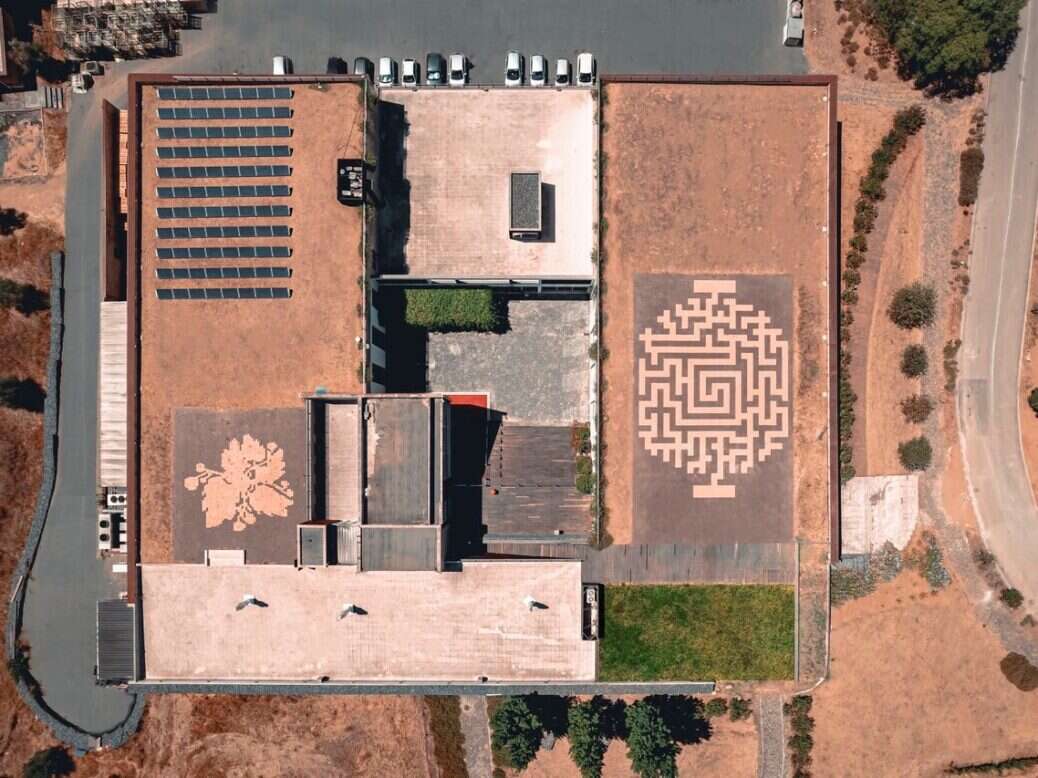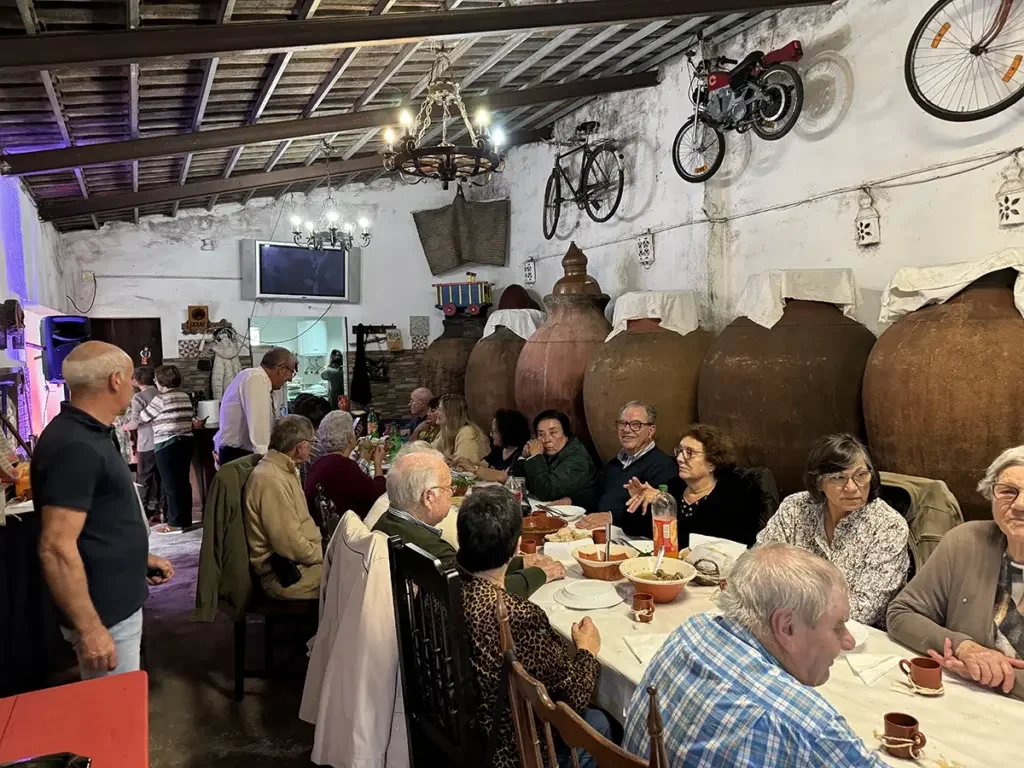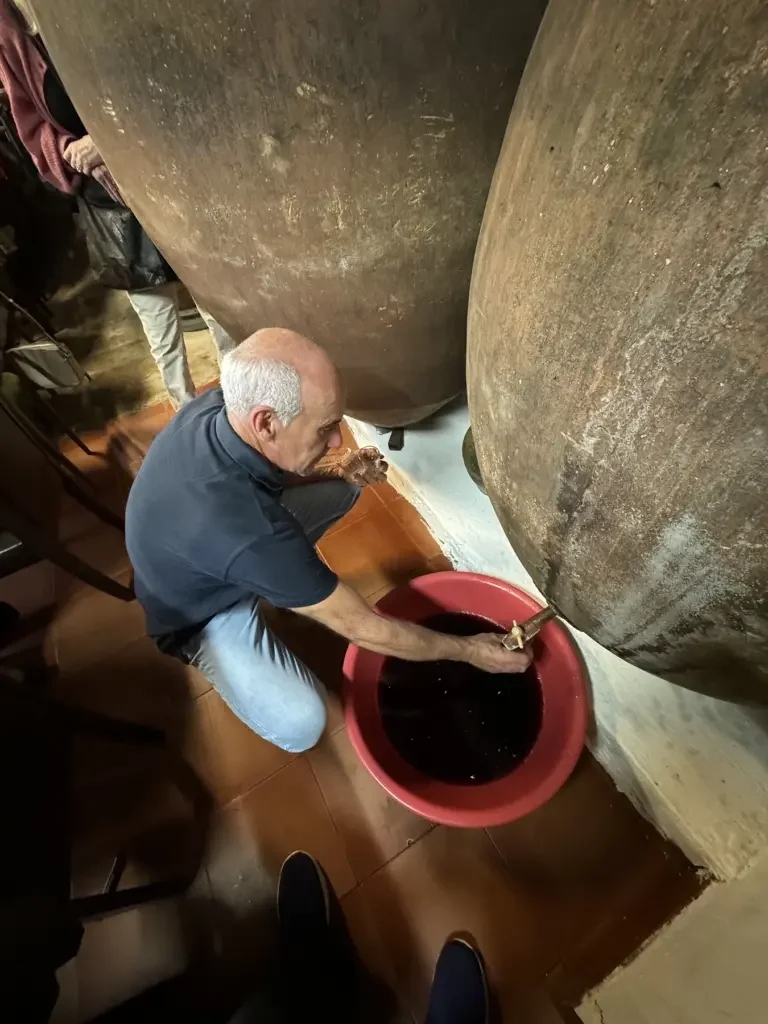
Alentejo’s annual Amphora Day offers a snapshot of both the current state of claypot winemaking globally, but also the ongoing resurgence of local talha claypot wine production.
Since 2018, the event has been held within Herdade do Rocim’s ultra-modern, eco-friendly winery. Fittingly, Rocim is surrounded by Portugal’s most traditional talha pot winemaking villages. There, in Vidigueira, Vila Alva, Vila de Frades, and Cuba, the last vestiges of Roman (probably Phoenician) claypot winemaking tradition remains unbroken since antiquity.
This year the event coincided with traditional St-Martin’s Day celebrations (November 11). This important day marks when Vinho de Talha DOC certification begins and the new season’s wine is drained from the bottom of talhas and served directly to tables filled with thirsty villagers in local adegas, tabernas, and restaurants.
The event hosted 60 exhibitors from as far afield as South Africa, Italy, France, Spain and Georgia, fleshed out by 34 Portuguese talha wine producers. Sadly, no Americans, Australians, or war-weary Armenians attended this year. Nevertheless, a full gamut of claypot wine styles were available to taste.
Three stylistic categories of amphora wine
Generally, wines slotted into three stylistic categories, revolving around length of grape skin contact and time kept under terracotta’s influence. Extending skin contact increasingly unlocks flavors and tannic structure from skins. This, in turn, is buffered by controlled oxidation coming through pot walls, resulting in softer, longer, more integrated, polymerized tannins. These often go hand in hand with enhanced grape purity and intensified varietal characters.
Georgian qvevri practices traditionally favor around 6 months of skin contact, resulting in fuller, denser, more tannic, “orange”-colored wines.
In contrast, Alentejo’s Vinho de Talha DOC rules require around three months’ contact, resulting in lighter colors and textures with fresher aromas and acidity—friendlier to modern tastebuds.
The broader undefined “amphora” category is more freeform. It can range between no skin contact, up to the most extreme lengths of contact. Another focus is on time spent fermenting and/or maturing in pots as an alternative to barrique conditioning. This “anything goes” approach can result in entirely new, groundbreaking wine styles.
All of these were brilliantly on display at this year’s Amphora Day.
Georgia’s large delegation of 11 qvevri producers offered its widest range of styles so far. Although generally showing firmer tannic structures, denser textures, and darker colors, differing grape varieties and climates were more at play this time, breaking stereotypes.
Georgia’s cooler, more westerly regional climates often employ less skin contact, creating lighter, brighter, and crisper styles than those from hotter eastern regions. Winery Khareba Monestery Qvevri Wine Tsitska 2019 11.5% was a good example of lighter, finer styles versus fuller, firmer Meskhisvilli Family Winery 2020 13.5%, a Rkatsiteli, Mtsvane, and Kisi co-ferment.
Meskhisvilli’s winemaker offered an interesting take on talha wine. He felt grapes were picked too unripe and wines drunk when too fresh, and preferred Georgia’s ultra-ripe, long skin-contact styles, designed for longer-term bottle aging.
Talha wines: Growing by leaps and bounds
Meanwhile, Alentejo’s talha wines are clearly growing by leaps and bounds in terms of quality and production. Overall, increased familiarity is driving a more effective use of talha in light of fruit, seasonal change, and vineyard terroir. A major generational turnover to younger, more professionally trained enologists and viticulturalists is bringing greater consistency, complexity, and refinement, alongside a marked reduction in rusticity. Geracoes, Honrado, and Quinta da Pigarca all follow this trend. Thankfully, positively charming rusticity can still be found in village wines served directly from pots.

Stalwart talha wine producers continue to crank out gold and silver medal-level, authentic Vinho de Talha DOC. Esporao’s old-vine, own-rooted Moreto and Rupeiro consistently overdeliver. So too Rui Reguinga’s high-altitude, old-vine, field-blended Terranus Tinto and Branco. XXVI Talhas remain solidly made, expressive, and interesting across a broad range of talha specific bottlings. Vidigueira Cooperative’s Branco, made from 120+ year-old field blends, remains a stellar bargain.
Standard bearer Herdade do Rocim’s excellent range of talha-made wines are widely available in 20+ countries, offering consumers an easy entry point to this ancient technology. All shine with a style that has steadily evolved towards more precision, polish, and refined elegance. Their ubiquitous Fresh from Amphora is great value: light, fresh, invitingly aromatic, and crisply made. Rocim’s Vinho de Talha DOCs are faithful to the form, albeit better integrated and more finely viscous than most. From the reserve range, Bojador gets close to Burgundian transparency and Clay Aged is fuller and richer than most anything barrique-made, but without the added oaky characters.
Sovibor, working 85 talha in cool Borba climates since 1968, offered up a silky smooth, long-finishing Mamore Amphora 2019 13.5% 18.5/20. Nearly as persistent, Mamore 100% Moreto 2018 is fresher, spicier, and juicier than more southern grown Moreto. 17.5/20
Estremoz’s Howard’s Folly Tres Anforas Branco 2022 12.3% consciously employed a 1-2mm protective coating offlor specifically to increase reduction. Initial flor nuttiness quickly dissipates into fresh, citrusy, florals. Ultra-clean and tightly focused, this gastronomic style has plenty of plucky acidity. 16/20
Relative newcomers Talha Mafia follow XXVI Talha’s lead with individual talha bottlings, Revolver the best of the lot. Lisbon’s urban winery, Adega Belim, create a compelling dry Setubal Muscat.
This year Canano, Adega do Teso, and Quinta do Panhal popped up almost out of nowhere, from the previously unknown northern talha village of Cabeção, where 50 producers with 500 historic talha continue to make Roman-era wine styles. Who knew?

Amphora wine beyond Alentejo
Outside of Alentejo, newish Algarve producer Arvad takes its name from a nearby river the Phoenicians once rowed up, trading for native Tartessian wine. Their unique 11% talha-made Negra Mole Branco 2023 is unexpectedly full of pear, passionfruit, and pineapple fruit and florals, sappy acidity and fleshy textures. 16/20
Well beyond Portugal, South Africa’s Lokaia (Franschhoek region) lean towards a Vinho de Talha DOC formula with 2 months of skin contact and preservation under an olive oil film. Super-clean Lokaia Semillon 2022 (10.5%) is brightly lit and linear, tightly packed with lemony, beeswax varietal characters throughout. 16/20
Bordeaux’s Château de Piote temper their 2018 Malbec in amphora for a year. Counter-intuitively, they find their Malbec is always fresher and finer-tannined than in less oxidative barrique. I found Malbec’s mid-palate, dusty tannins, considerably finer and lengthened well into the finish. 16.5/20 Reversing direction, inky black Château Couronneau Maceration de Couronneau 2020 15%, extracts every last drop of color and tannins from skins, using amphora to pull back excessive chunkiness into something drinkable. Intensely Merlot, it begs for more bottle age. 16.5/20
From both his name and the origins of his wine, I hadn‘t expected Daniel Ramos to be Australian. Ramos works high-altitude, old-vine, Castilian Garnacha in Spanish tinajas. Kept on skins for 11 months and drained via a talha-like lower hole into bottle, his red and rosé were intriguingly edgy, difficult to describe, and worth experiencing.
Just across from Portugal’s talha country, Estramadura’s first organic producer continues to use talha-like, holed pots. Prelvin lines these with beeswax pes, refreshed every three years. This influence is evident in their 2021 Alicante Bouchet, with the spicy, fresh black fruits positively tinged with beeswax aromas, even more so in the mouth. 16/20
Amphora Day never fails to surprise for its depth of diversity and ability to pull in so many of the world’s leading clay-pot winemakers. Nowhere else in the wine world provides such a magnificent juxtaposition between old and new.
The best way to enhance that experience is to wander around the talha tabernas during festivities in the surrounding villages on the nights before and after Amphora Day.
This is truly one of wine tourism’s greatest hidden gems.






